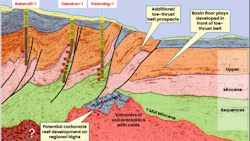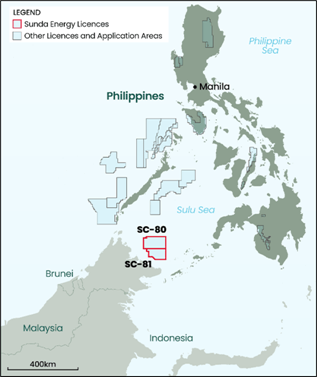Triangle Energy-led group awarded two exploration blocks offshore the Philippines
Sunda Energy has gained 37.5% interests in two license blocks in the Sulu Sea offshore the Philippines, under the 1st Conventional Energy Bid Round of the Bangsamoro Autonomous Region of Muslim Mindanao.
Triangle Energy (Global) will operate both the service contracts SC-80 and SC-81, also with a 37.5% stake. The other partners are PXP (12.5%) and Philodrill (12.5%).
Both service contract blocks are in the southwest of the Sulu Sea, over the Sandakan Basin, in water depths ranging from 100 m to 3,000 m. According to Sunda, the main play is Upper Miocene turbidite sands trapped in toe-thrust anticline structures and basin floor stratigraphic traps in the deepwater areas.
There is further prospectivity in Middle to Upper Miocene shallow-water sandstones in the west and in deeper Miocene carbonate reef features.
SC-80 covers much of the area of a former service contract (SC 56), where some individuals on Sunda’s team worked with a previous operator, Mitra Energy.
ExxonMobil also farmed into the acreage, drilling four exploratory wells in the deepwater fold belt play in 2009-2010, finding gas with the Dabakan-1 (75 m net pay) and Palendag-1 wells (47 m net pay), and a smaller gas resources at Babendil-1 (39 m net pay).
Although ExxonMobil pulled out in 2011, TotalEnergies farmed into the block a year later, acquiring additional 3D seismic data. The company had planned to drill the potentially giant Halcon prospect, an anticlinal structure thought to be a basin floor turbidite fan sandstone complex trapped against the frontal thrust of the fold-belt.
However, drilling plans were cancelled following strategic changes in 2016, and the block was relinquished in 2020.
Mitra Energy commissioned a Competent Persons Report for the five key main identified prospects, estimating 10,088 Bcf of gas and 247 MMbbl of associated liquids.
SC-81 to the south contains a slope clastic play where two wells encountered oil and hydrocarbon shows (Wildebeest-1 and Lumba Lumba-1), but likely missed more prospective target areas.
Five wells were also drilled in the shallow-water shelf area, which were either dry holes or had minor gas shows. But five discovered fields nearby offshore Malaysian waters suggests there is potential for gas.
The current joint venture plans to apply processing techniques to fully delineate the gas discoveries and de-risk the exploration prospectivity. This could lead to identification of new high-impact appraisal and exploration targets for future drilling.
Both service contracts carry a seven-year exploration term, including two optional wells during the final three years.

